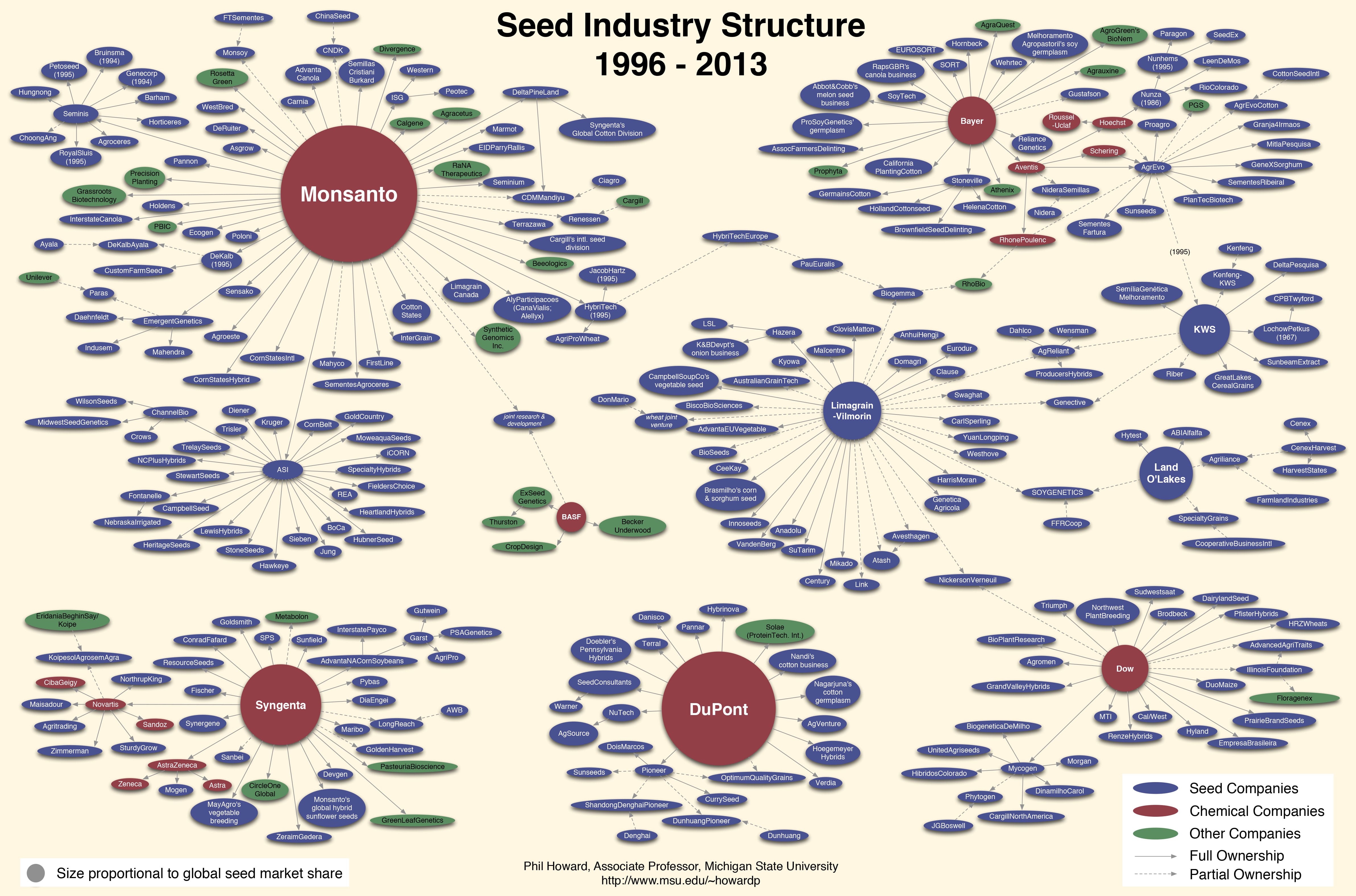(via cornucopia.org; click through for a larger image/to zoom in)
This is really scary to me. Within my economics background (and despite the fact that I don’t always agree with all the axioms we learn there), such a concentration of any particular industry is generally seen as bad news. “Oligopolies” (a situation where a small amount of sellers are facing a larger amount of buyers) give those companies massive market power; allowing them to set prices and control supply according to their best interests. The low competition means that competitors can effectively split up the market and exist comfortably next to each other without incentive to improve their product or change their pricing to appeal to customers. Furthermore, research has shown that private crop development research mostly leads to an increase in agri-chemical use, rather than a decrease, because such a high use obviously is of interest to the companies that simultaneously sell seeds and the accompanying chemicals, such as Monsanto and Syngenta up above. The scariest thing is that, beyond stringent pro-competition laws enforced on an international level, there are few avenues I can think of to remedy the situation, since these multinational companies don’t even have their headquarters in the same one country which could control them. 🙁

The complex and costly processes for the registration of seeds plays right into the hands of these “big boys”.
This is a great graphic! It is frustrating to me that in the discussion on GMOs or other biotechnology people conflate the technology (which can be good/bad) with the vendor. But I think we should all focus on the fact that there is an unhealthy concentration of economic power in the industry and no easy way to change that, as you point out.
That’s both fascinating and terrifying. I really love what Thought+Food has said about that confusion in the GMO debate. My biggest problem with GMO foods isn’t their existence in and of themselves, it’s my fear of such a small group of organisations basically holding the keys to EVERYTHING we eat.
Have you read Paolo Bacigalupi’s Wind-Up Girl? I’d really recommend it to anyone interested in GMO oligopolies.
I totally agree with you both! That’s the point I try to make whenever I talk about GMOs as well.
So how we would we begin to think of a more solid international framework of control? Frameworks and conventions are abundant. In the European Framework on GMO, for instance, it is stated: “Safety: The product must be safe and cannot pose threats to human or animal health. It also must be safe for the environment. All products from GMOs must be considered just as safe as their conventionally derived counterparts according to tests using the most advanced knowledge and technology available. If this isn’t the case, the GMO will not receive authorisation.” In my view, the problem often comes down to semantics and subjective viewpoints. What does “safe” mean? Frequently even the most advanced science fails to take into account a chemical byproduct or long-term repercussion that will not be possible to reverse at a later stage.
Probably we need to rely on a precautionary approach. That would be bad news for a lot of hungry small-scale farmers in desert regions. But, as one recent delegate at a GM conference said, “offering GM food as aid is like giving a Hindu farmer beef to eat.”
In South Africa, the country will not accept GM maize for food aid because of fears that it could “infect” naturally grown maize. Therefore it can only be imported in a milled form. Whether these sorts of piecemeal solutions will be enough in the longer term must surely be highly questionable.
http://greens-efa-service.eu/concentration_of_market_power_in_EU_see_market/
one more interesting new document on the topic, if you are interested 🙂
Thanks so much, I’ll make sure to check it out!!